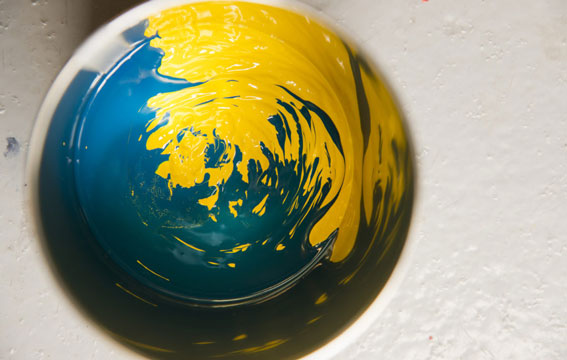- Equipment
- Inks & Supplies
- Services
- Applications
- Tagless
- Resources
- About Us
- Contact Us

Garment printer ink as applied by tagless pad printing can bend and stretch without distorting the print at all. It almost appears to be part of the garment, but why?
Garment printer ink is a pad printing ink formulated for garments. Much like any other line of pad printing ink, garment ink is designed to adhere best to garments. The ink is applied to the garment via a pad printing machine. A pad printer enables the transfer of a two-dimensional graphic to a three-dimensional object. The graphic is transferred by etching the image into a pad printing plate. The plate is placed in the pad printer and an ink cup, filled with your choice of ink and color, is placed on top of the plate. The ink cup slides back and forth over the etched plate graphic to leave only a trace amount of ink in the etch while removing any excess. A pad then presses on the etch to pick up the ink and then presses down over the garment to transfer the image.
Unlike other imitation tagless printing methods, tagless pad printing of garment ink will not crack when stretched or bent. The ink is made specifically to be elastic and durable. To spring back in place with the garment. When the garment printer ink is applied, it is essentially embedded into the fibers of the shirt. Other tagless printing methods, such as heat transfers, use a lot of ink and leave the label on the surface of the garment. Leaving it susceptible to general wear and tear. The excess thickness of the label makes it more brittle and more likely to crack.
While, yes, the garment ink itself is embedded into the fibers of the garment, it still won’t show through to the other side of the garment. Tagless pad printing utilizes such a small amount of ink for each print (each can of ink will print about 100,000 tagless labels). Even intimate apparel, where the material is thin and often see-through, won’t show the print through the other side because the ink becomes one with the garment. In contrast, other print methods use too much ink, the label sits on top of the garment, or even worse, is a sewn-on label, completely disrupting the natural look and feel of the garment.
We all hate that annoying feeling of a tag sticking into our necks or the scratching of the heat transfer label. Garment printer ink, when applied by tagless pad printing, leaves no feel to it at all. When you run your hand over it, you feel the garment, not the print. This is due to the ink becoming embedded into the garment fibers, and not sitting on top of it.
So, yes, garment printer ink may seem magical when applied via tagless pad printing. Not only does it become one with the garment, but it’s also the most cost-effective garment labeling solution out there.
Additional Resources
Learn more about Tagless Label Printing
Back to Blog Home
Add Your Comment